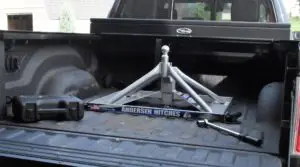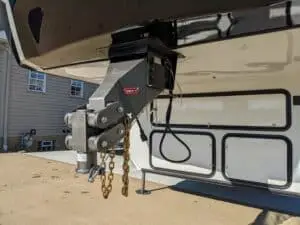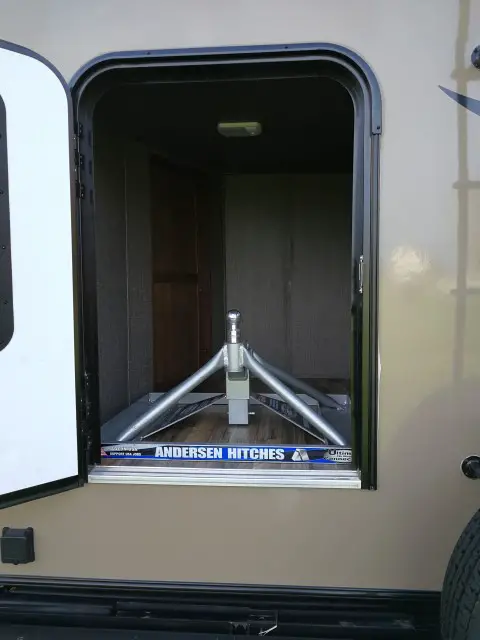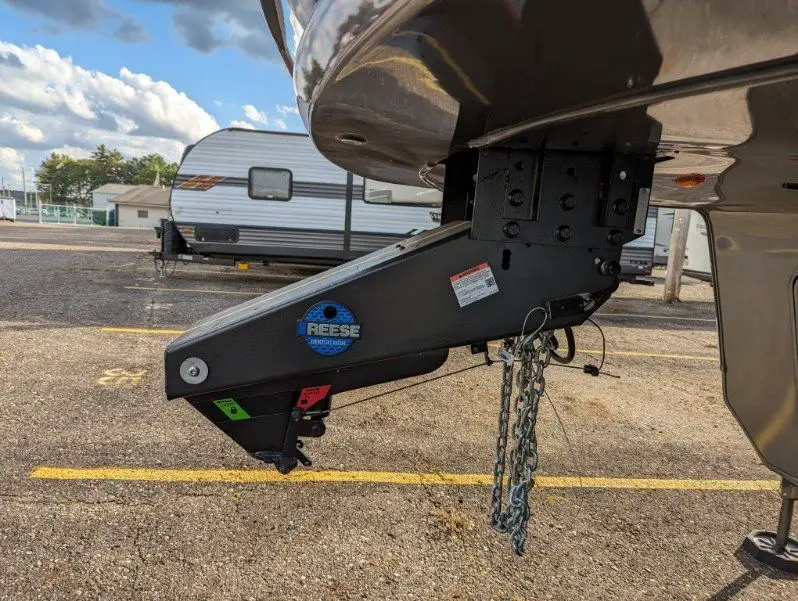After using both the Gen-Y Executive Gooseneck Coupler and the Andersen Ultimate 5th Wheel Connection for over a year each I would choose the Gen-Y again in most cases.
Traditional 5th wheel hitches like the B&W Companion hitch have been around for a long time and there’s a good reason for that, they just work. According to the American Trucking Associations (https://www.trucking.org/economics-and-industry-data) there were 195.62 billion miles traveled by combination trucks in 2021 those Semi-trucks are using essentially the same connection as our 5th wheels just on a larger scale.
So why not use a traditional hitch?
For me the reason is convenience. Unlike Semi-Trucks that spend their whole life pulling trailers, my truck gets used for many other things like trips to the local home improvement store or moving furniture. Moving a heavy 5th wheel hitch in and out of the bed of your truck can quickly become a hassle you don’t want…
The Gen-Y Gooseneck Coupler and Andersen Ultimate 5th Wheel Connection both simplify the change from towing to using your truck bed for other things.
What about your frame warranty?
One of the biggest concerns when changing from a traditional hitch to a gooseneck or Andersen hitch is the frame warranty. Honestly, this shouldn’t really be a concern. In most cases the frame warranty that comes with your RV is good for 1 to 3 years, after that you are on your own. If you have a used RV your warranty is most likely gone. If you are considering making the change on a new RV you may run the risk of voiding your warranty, but I spoke with someone at Lippert and unofficially, I was told that unless there is evidence that the use of the hitch caused the damage they will still repair the frame.
Now, Lets compare the Gen-y Gooseneck Coupler and the Andersen Ultimate
As I mentioned before I have personally used both hitches for over a year each and you can check out my YouTube Playlist for videos on them. For this comparison I’ll break it down into the pros and cons of each and then explain why I chose the Gen-Y as my favorite and when I think the Andersen or even a traditional 5th wheel hitch might be a better option for you.

VS

Andersen Ultimate 5th Wheel Connection
The Andersen Ultimate connection comes is a few different variations. They can attach to your bed via the industry standard rail system or a gooseneck ball. No matter which style base you choose they all use the same ball coupler that bolts on to the existing 5th wheel king pin. Click here to read my review of the Andresen Ultimate.
Installation of Andersen
The initial installation has 2 parts, the ball coupler and the base.
Installing the ball coupler is a simple process the involves sliding the block over the king pin, installing 2 bolts around the pin and then tightening several set screws that push against the plate of the pin box to prevent the coupler from moving. This takes 15-20 minutes and is only done the first time you use the hitch.
One nice thing about the Andersen hitch is that if you ever need to move your RV using a traditional 5th wheel hitch, the block can be easily removed from the pin box.
The second part is installing the base into your truck. If you have a rail system version you set the hitch onto the rails, install the pins and you are done. For the gooseneck ball version, you need to install the ball into your truck first. Then the hitch drops over the ball and is secured with a pin below the head of the ball.
Then it must be torqued from the top once prior to connecting the camper and then again once the weight of the RV is on the hitch. After the second torquing of the main bolt there are 2 bolts on the back side of the hitch that keep it locked in place.
This process takes about 10 to 15 minutes and must be done every time you switch between towing and using your truck bed for other things.
Connecting your RV with the Andersen Ultimate Hitch
Once the hitch is installed the process of hooking up is about the same as any ball hitch.
- Extend the front landing gear until the coupler is above the height of the ball.
- Back in until the hitch is aligned with the coupler.
- Lower the RV down onto the hitch.
- Secure the locking mechanism by sliding the lever and turning it to lock in place.
While not quite as quick as backing into a traditional 5th wheel hitch, the Andersen process is pretty easy and the ball being high in the air makes it easier to see if you are properly aligned. The ball funnel on the Andersen coupler is also forgiving and helps if you are a little off.
Towing with the Andersen Ultimate Hitch
In use the Andersen hitch provides a solid connection between the truck and trailer with very little movement. This results in a smooth ride without much bucking and chucking. The exception that there is no cushioning between the truck and trailer, so any bumps or highway joints do get transferred to the tow vehicle.
Storing the Andersen Ultimate hitch when not in use

The light weight of the Aluminum Andersen Ultimate hitch base makes it easy to store when not in use. One person can remove it from the truck, in fact I frequently carried my hitch with one hand. In my case once I removed the hitch from the truck I used to set it right inside the rear door of my camper. Others used hooks screwed into the wall of their garage to hang the hitch somewhere out of the way. This is one major advantage over a traditional 5th wheel hitch.
There are a few things I still don’t like about the Andersen hitch.
First, you still need to remove the base and store it somewhere when you want to free up your truck bed. While it’s way easier to deal with than a 5th wheel hitch, it still takes up a decent amount of space.
Second, as I said above in the towing section, the Andersen hitch doesn’t provide any cushioning between the truck and RV. In fact, if you have a Rota-Flex pin box there is a lockout kit that needs to be installed to prevent it from moving.
The elephant in the room when it comes to the Andersen Ultimate 5th Wheel Connection
One question you see all the time in forums is how strong is the Andersen Hitch, will it fail?
I can say that in 3+ years towing a 12,00 lbs, 38ft Cougar fifth wheel with the Andersen hitch I never had any issues with the strength of the hitch.
You may have seen pictures posted of mangled Andersen hitches. In most of those pictures the RV was involved in a crash and frankly RV’s aren’t designed to withstand an accident. Any accident with a strong enough impact to break the hitch probably resulted in the RV being totaled out and the insurance claim will be replacing your hitch. My father was rear-ended towing his 5th wheel with a B&W Companion hitch and even that hitch was damaged and had to be replaced.
Weight Rating of Andersen Ultimate Connection
- Gooseneck Version, 24,000 lbs GTWR with 4,500 lbs pin weight
- Rail Mount Version, 20,000 lbs GTWR with 4,500 lbs pin weight
Pros of using the Andersen Ultimate
- Light Weight Design for easy installation, removal, and storage.
- High Ball height makes connecting easier.
- Simple latching mechanism.
- Can be easily removed to tow with traditional hitch.
Cons of using the Andersen Ultimate
- Base still takes up space in bed and needs to be stored when not in use.
- No cushioning between truck and RV to smooth out ride.
- Max pin weight is 4,500 lbs.
Gen-y Executive Gooseneck Coupler
The Gen-Y Gooseneck hitch Comes in 2 variations and several different weight ratings. Due to the torsion spring design the hitch must be sized correctly for your 5th wheel. Otherwise, the springs will either be too stiff and not cushion the ride or be bottomed out because your RV is too heavy.
Auto-Latch vs Manual Latch Coupler
In my opinion the Auto Latch version of the Gen-Y Coupler is the only way to go!
- The Manual Latch Coupler works like a traditional gooseneck cargo or horse trailer. Once the coupler is seated on the ball a pin is inserted into the coupler preventing it from coming back off. This requires you to climb into the bed of the truck and install the pin.
- The Auto Latch Coupler simplifies the process by using a spring loaded latch that automatically engages when the coupler is lowered onto the ball. To release the coupler you just pull the cable while extending your landing gear and the coupler will lift off the ball.
Installation of Gen-Y Gooseneck Coupler
Unlike the Andersen Hitch, the Gen-Y Hitch completely replaces your existing pin box. The biggest concern when installing the Gen-Y Gooseneck is how you will support the 5th wheel pin box when removing it and the Gen-Y when bolting it up. Here’s a video from the installation of my Gen-Y.
- Most likely your emergency break away cable will be mounted to the pin box, the first step is to remove that.
- Next support the pin box and remove the bolts. I used the loader of my tractor to support the pin box, but I know others have used a cart or table. If you remove all but 1 bolt on each side you can swing the pin box down, then remove the last to bolts and lower the other half. If your hitch has been on for a few years the bolts may be rusted making them harder to remove.
- The installation of the Gen-Y is just the reverse. Move the hitch into position, lifting it up to get 2 of the bolts started and then swing it into position to align the remaining bolt holes. Then torque them down.
- Lastly mount the break away cable to the new Gen-Y hitch.
- If your truck already has a gooseneck ball there isn’t anything to install in the truck.
Compared to the Andersen Ultimate install the Gen-Y is a little more difficult but can still easily be done if you’re a handy person. Of course, having the hitch installed by a dealer is always an option, but that will add a lot of cost to the Gen-Y.
Connecting your RV with the Gen-Y Executive Gooseneck Coupler
The process of hooking up to the Gen-Y gooseneck is the same as any other gooseneck trailer and about the same as the Andersen.
- Extend the front landing gear until the coupler is above the height of the ball.
- Back in until the hitch is aligned with the gooseneck ball.
- Lower the RV down onto the ball. If you have the auto connect version that it!
Towing with the Gen-Y Executive Gooseneck Coupler
Towing with the Gen-Y is better than many other hitches. The torsion spring design of the hitch helps to isolate bumps in the road from the truck giving a smoother ride than the Andersen or many 5th wheel hitches and pin boxes.
In use this Gen-Y handles bumps in the road quite well. The only area that I have experienced any problems is occasionally when crossing bridge expansion joints on the highway there is a slight bouncing effect that lasts for a few seconds after crossing.
Storing the Gen-Y Executive Gooseneck Coupler
This is a major win for the Gen-Y. There technically isn’t anything to store when it comes to the hitch itself. To clear your bed for other things all you need to do is remove the gooseneck ball. If your truck is equipped with a gooseneck prep package like my Ram the ball can be removed in a matter of seconds and you bed if completely cleared for anything else you would like to use it for.
Weight Rating of Gen-Y Executive Gooseneck Coupler
- Max: 25,000 lbs GTWR with 6,500 lbs pin weight
The Gen-Y comes is several weight ratings that match the torsion springs to the trailer weight. Their sizing chart tells you to multiply your trailers GVWR by .22 and use that to select the right size hitch. Here is a list of the weight ratings and calculated values suggested on the Gen-Y website:
- 3,500 lbs pin weight model, 1,600 – 2,599 lbs
- 4,500 lbs pin weight model, 2,600 – 3,599 lbs
- 5,500 lbs pin weight model, 3,600 – 4,599 lbs
- 6,500 lbs pin weight model, 4,600 – 5,599 lbs
- 7,500 lbs pin weight model, 5,600 – 6,599 lbs
- 8,500 lbs pin weight model, 6,600 – 7,599 lbs
Pros of the Gen-Y Executive Gooseneck Coupler
- No hitch to install or remove and store from your truck bed.
- Torsion spring design to provide a smoother ride.
- Easy connect and disconnect with the auto connect version.
Cons of the Gen-Y Executive Gooseneck Coupler
So far I haven’t come across many reasons to not love the Gen-Y.
- Slightly harder to see when backing in to hookup if you don’t have a bed camera.
- Converting from a 5th wheel pin box to the gooseneck couplers means you cannot move the 5th wheel with a traditional hitch anymore. In most cases this isn’t a problem, but if you breakdown, take your RV in for service or need to have someone else move the trailer you might be a little more limited.
- The hitch is matched to your trailer weight. This means if you get a new 5th wheel and the weight doesn’t match up, you might have to purchase a new Gen-y instead of just moving it to the new camper.
Other Options
While the Andersen and Gen-Y are both popular replacements for your 5th wheel hitch there are a couple of other options out there.
Reese Goosebox
The Reese Goosebox is another excellent alternative when looking for an easy to use hitch that won’t take up a lot of space in your truck bed.
The Goosebox design is very similar to the Gen-Y, converting your 5th wheel to a gooseneck ball connection. The biggest difference is the way the Goosebox isolates movement between the truck and trailer. Instead of using a torsion spring design the Reese hitch uses 2 internal shock absorbers and an air bag. An advantage of this design over the Gen-Y is that the air pressure can be changed to adjust for trailer weight.

When I was shopping for a hitch the Goosebox was not available for the Lippert Rhino Box Pin Box design, but a new model was released that is compatible with the Rhino Box.
Another plus for the Reese Goosebox is that is has been tested and certified to not void your Lippert Frame Warranty.
Reese Goosebox Weight Capacity
The Goosebox comes in 2 weight capacities:
- 16K, 16,000 lb GTWR, 2,300 lb max pin weight
- 20K, 20,000 lb GTWR, 4,000 lb max pin weight
Towing with the Reese Goosebox
While I do not have personal experience towing with the Goosebox, my father does. He has been towing his 38ft Montana 5th wheel for about a year using the Goosebox and has been very happy with the performance.
Lippert (LCI) Gooseneck Connect 21K
The Gooseneck Connect is built by Lippert, that means it has also been approved for use by Lippert and will not void your chassis warranty. In my opinion that and the price are the only advantages of the Gooseneck Connect.
It looks like they gave their design team some existing parts and asked them to make a gooseneck hitch from them. The top looks like a standard 5th wheel pin box and the gooseneck coupler looks standard as well, they just added some large gussets to stiffen everything up and welded it together.
Similar to the Andersen Ultimate hitch, this one provides no method of cushioning the ride.
LCI Gooseneck Connect 21K Weight Capacity
The Gooseneck Connect only comes in 1 size rated at 21,000 GTWR, I could not find the pin weight rating published for the Gooseneck Connect.
Gooseneck adapters for existing Pin Box
The last option I’ll mention is using a gooseneck adapter on your existing pin box like the Andersen Ranch Hand. Some slide over the king pin and others require that the king pin be removed before installing the adapter. I would not recommend this style adapter except for occasional short trips. 5th wheel pin boxes are not designed for the way these adapters attach and transfer the loads to the trailer.
Which would I pick Andersen Ultimate or Gen-Y Executive Gooseneck
I answered this at the very beginning of the article, and after reading this far I’m sure you can tell.
I would hands down pick the Gen-Y over the Andersen Ultimate.
With that said I think there is a case for choosing the Andersen. If you frequently switch between different trailers, have different people hauling your trailer or are a transport driver, you might want to go with the Andersen. The reason is that the Andersen coupler can be easily removed and then the trailer can be towed using a traditional hitch.
Another case where I would suggest not using either hitch is if your truck is dedicated to only towing your 5th wheel. In that case I would go with a high end 5th wheel hitch like the Hensley TrailerSaver for best ride possible.
